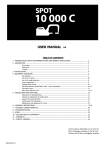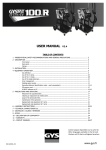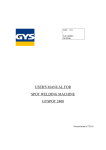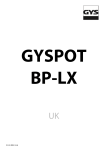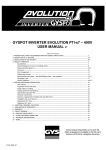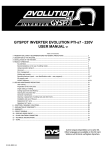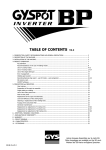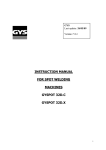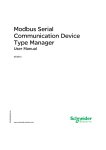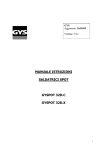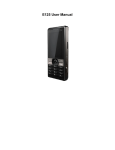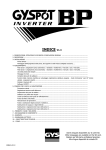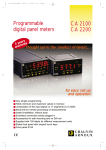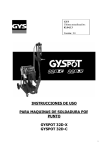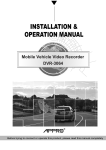Download GYSPOT PTI Evolution_V2.10.00_ENG
Transcript
USER MANUAL V2.10.00 TABLE OF CONTENTS 1- PRESENTATION, SAFETY RECOMMENDATIONS AND GENERAL PRECAUTIONS ........................... 2 2- DESCRIPTION OF THE MACHINE ............................................................................................................. 3 - GYSPOT PTI Font panel .................................................................................................. 3 GYSPOT PTI Rear panel .................................................................................................. 3 C-Clamp ........................................................................................................................ 3 3- INSTALLATION OF THE MACHINE ............................................................................................................ 4 - Before use ..................................................................................................................... Assembling the clamp handle .......................................................................................... Filling of the cooling liquid tank........................................................................................ Starting the machine....................................................................................................... 4 4 4 4 4- PRODUCT OPERATION ................................................................................................................................ 5 - Key definition ................................................................................................................. C clamp modes (standard / manual / multisheet / Auto / clamp adjustment)........................ Use of the single sided gun ............................................................................................. Error management.......................................................................................................... Welding spot counter ...................................................................................................... Recording features (log report – User ID mode - user programs) ........................................ SD memory card ............................................................................................................ GYSPOT software ........................................................................................................... Use of the pneumatic C clamp ......................................................................................... Installation and use of the single sided gun ...................................................................... 5 6-7 8 9 9 10-13 13 14-16 16 17 5- PRECAUTIONS OF USE AND SERVICING ................................................................................................ 18 - User training .................................................................................................................. Preparation of the parts to assemble ................................................................................ Single sided gun welding ................................................................................................. Replacement or adjustment of C clamp arms ............................................................... 18 18 18 18 - Adjustment and tightening of C-Clamp arms in their holder………………………………………………19 - Type of arms for the C-clamp ......................................................................................... Use of the C2 and C8 arm ............................................................................................... Replacement of the caps and electrodes ........................................................................... Level and efficiency of the cooling liquid ........................................................................... cleaning or replacement of the welding tools..................................................................... purging of the pneumatic filter......................................................................................... generator maintenance ................................................................................................... 21 22 23 23 23 23 23 6 - CHARACTERISTICS ..................................................................................................................................... 24 7 - PICTOGRAMS ............................................................................................................................................... 25 S102 Last update 26/03/2010 Autres langues disponibles sur la carte SD. Other languages available on the SD card. Weitere auf SD-Karte verfügbare Sprachen. Thank you for your choice ! Before installing and using the product or before maintenance, please read carefully the following safety recommendations in order to avoid accidents to the users and damage of the welding process. GYS cannot be held responsible for the damages occurring to persons or belongings, following the use of the machine in the following circumstances: - Modification or disabling of safety elements, - Non-respect of the recommendations written in the user manual, - Modification of the characteristics of the product, - Use of accessories other than the GYS accessories , or accessories not adapted to the machine - Non-respect of the regulations and particular dispositions in the country where the machine is installed. 1- PRESENTATION, SAFETY RECOMMENDATIONS AND GENERAL PRECAUTIONS This product has been designed to carry out the following operations in car body workshops : - Spot welding on metal sheets with a pneumatic clamp, - Welding of metal sheets with a single sided gun, - Welding of nails, rivets, washers and studs, - Repair of bumps and impacts (impacts of hail with the option « quick repair”). GENERALITIES 1. The operators must have followed up an appropriate training. 2. The repair and maintenance operations can only be performed by qualified personnel. 3. The operator is responsible for the respect of the car manufacturer’s recommendations, regarding the protection of the car electrical and electronic equipments (car computer, car radio, alarm, air bag, etc…). 4. Before any repair or maintenance operation, the compressed air supply must be disconnected and depressurized. 5. The electrodes, arms, as well as the other secondary conductors can reach a very high temperature and remain hot very long after having stopped the machine. Pay particular attention to the risks of serious burns. 6. It is necessary to make a regular preventive maintenance on the machine. MAINS SUPPLY 1. Check whether the unit is correctly connected to the earth and that the connection to the earth is in good condition. 2. Check whether the workbench is connected to the earth coupler. 3. Make sure that the operator has no contact with the metal parts to be welded without any protection or with wet clothes. 4. Avoid being in contact with the welding part. 5. Do not make any spot welding operations in very wet areas or on a wet floor. 6. Do not weld with worn out cables. Make sure that there is no isolation defect, nor stripped cables nor loose connections, and that there is no cooling liquid leaks. 7. Before performing any control or maintenance operation, switch off and disconnect the unit directly from the plug. EYE AND BODY PROTECTION 1. During the welding process, the operator must protect himself from possible projections of steel in fusion with clothes like : leather gloves, welding aprons, safety shoes, welding helmets or glasses for filtering radiations and projections. Similarly, during grinding or hammering operations, the operator must wear eye protection. 2. The tightening force of the clamp can reach 550 daN. Keep away all body parts from the mobile elements of the clamp to avoid any risk of squeezing, of fingers in particular. 3. Do not wear rings, watches, or jewellery, which are current conductors and can cause serious burns. 4. All the protection boards must be in good condition and maintained in place. Never look at a welding arc without any eye protection. Protect the environment near the product against projections and reflections. FIRE 1. 2. 3. 4. 5. Make sure that the sparks will not cause fire, especially near flammable material. Check that fire extinguishers are near the operator. Use the product in a room with extractor fans Do not weld on combustible or lubricant containers, even empty, nor on containers containing flammable material. Do not weld in an atmosphere charged with flammable gas or fuel fumes. ELECTRO-MAGNETIC COMPATIBILITY Near the spot-welding machine, check whether : - there are no other power supply cable, no control lines, no telephone cables, no radio or TV reception appliances, no watches, no mobile phones, no magnetic cards, no computers nor any other electronic appliance. - there are, in the surroundings, no persons using active medical appliances (pacemakers, acoustic prosthetics). Plan extra protections if other products are to be used in the vicinity of the machine. This product is designed to be used in an industrial or professional environment, as defined in the CISPR11 publication. In a different environment, it might be difficult to ensure electromagnetic compatibility. 2 CE MARK GYS testifies that this product has been designed and manufactured in conformity with the following European standards : - Low Voltage Directive 2006/95/EC in application of the norm EN 50063 and EN 50178 - Electromagnetic Compatibility Directive EMC 2004/108/EC in application of the norm EN 62135-2 - Machines directive 2006/42/EC in application of the European standad EN 60204-1 - Exposure of workers to electromagnetic fields directive 2004/40/EC dated April 29th 2004 2 – DESCRIPTION OF THE MACHINE BP Front panel SD Card Reader Display board for communication with the user Rear panel 25 A D-curve switch, 30 mA Earth leakage circuit breaker Pneumatic filter, connection to the pneumatic network system C Clamp Button B : to open / close the clamp Button : remote control of the sheet’s thickness Locking /unlocking C - lever C arm Mobile electrode 3/25 3- INSTALLATION OF THE MACHINE Before use Several verifications are necessary before using the unit to ensure good performance of the machine. Here are the verifications to do : Check the electrical line voltage : it should be 400V AC, 3 phases, with a 25 A or more delayed circuit breaker, curve D (or fuse of aM type) and with an Earth Leakage Circuit Breaker of 30 mA. Check the cross section of the cable going from the main electrical board to the socket where the machine will be plugged : it should be 4x6 mm2. If this cable is longer than 10m, use a conductor size of 10mm². If you use an electrical extension cord, use a 6mm² conductor size (10mm² if electrical line + extension cord total length is superior to 10m). Connect a 3 phases + earth plug (minimum 32A) on the supply cable. - - - - Be careful: in order to avoid voltage drops which can generate bad welding spots, you must never have overloaded electrical lines, nor supply cable diameters which cross section are not large enough. Also, the mains plugs must not be too far from the circuit breaker. If the machine is not sufficiently supplied, it is not possible to ensure a good welding quality. Check that the air compressed network can deliver a minimum of 7 bars (dry air), then connect the compressed air network on the back of the machine. The machine must not be used on an air compressed network with a pressure inferior to 3 bars. Assembling the clamp handle, Handle : Assemble the handle on the left hand side of the clamp. Air connector Assemble the air connector on the air filter. Filling of the cooling liquid tank To fill the cooling liquid in the tank, please proceed as follows : put the pneumatic clamp on its stand pour cooling liquid in the tank to reach the maximum level indicated on the tank (~30 litres). Starting the machine Position the switch on the ON position. The electronic card starts a test and initialisation cycle of the parameters during a period of about 10 seconds. At the end of this cycle, the machine is ready to be used. When the machine starts to work, liquid circulates in the cables. Check that there are no leaks. 4/25 4- PRODUCT OPERATION Key definition Key - Pressing this key allows to select the tool that will be used : either clamp or single sided gun. For the BP.LCX machine, pressing this key changes the mode from C clamp to C clamp adjustment, X clamp, X clamp adjustment, and finally single sided gun. The clamp adjustment mode allows to close the clamp and apply the programmed force on the electrodes with any current flowing. This mode is used to adjust the arms. - Pressing this key 2 seconds allows to come back to normal mode from the other modes. - Pressing this key 2 seconds brings the spot counter to zero, when it is displayed. - Pressing briefly twice this key erases the report that is displayed on the screen, when in the visualisation mode. - Pressing briefly this key when in program saving mode erases the selected program. Steel sheet thickness This setting allows to select the thickness of the steel sheets to weld. The sheet thickness can be adjusted using the + and – keys (in the circle, position 5). The thickness can be selected amongst the following preset values : 0.6, 0.8, 1.0, 1.2, 1.5, 1.8, 2.0, 2.5, 3.0 mm. Type of steel sheet This setting allows to select the type of steel sheet to weld, amongst 4 families : coated steel, HTS steel, UHTS steel, BORON steel. This setting can be adjusted using the + and – keys (in the circle, position 5). Arm used When a clamp is used (either C or X), the user should specify here the length of the arms fitted on the clamp, so that the machine will adjust automatically the air pressure to get the requested electrode force. 5/25 Use of the advanced modes The MODE key allows to navigate through 3 different modes : STANDARD MODE, MULTISHEET MODE, MANUAL MODE. A long press on the MODE key allows to enter the configuration mode, where the language and date can be edited and the sound alarm activated for “current too low” or “low pressure” messages. The up and down keys (in the circle) allow to select the parameter to modify (sheet thickness, type of steel, arm used). The + and – keys allow to modify the parameter. Save a report More details can be found on this function in the corresponding chapter. The « record » key saving of a report. The « visualise » key spots performed. allows to enable or disable the allows to read the sequence of Saving of user welding parameters The « save » key allows to save user welding parameters (mode, sheet thickness, welding current, welding time or electrode force) The “open” key allows to call back previously saved welding settings. The machine automatically goes to manual mode, recalling the saved parameters (current, welding time, force) and the tool used (clamp or gun). C clamp modes STANDARD Mode MULTISHEET Mode This mode is the default mode when the machine starts. It allows to easily perform a welding spot by selecting : - The tool to be used - The thickness of the sheets to be welded, to choose from 0.6, 0.8, 1.0, 1.2, 1.5, 1.8, 2.0, 2.5, 3.0. - The type of steel to be welded (Coated steel, HTS steel, UHTS steel, BORON steel) - The arm used. Pressing the up and down key (in the circle) allows to navigate from one parameter to the next (thickness, type of steel, arm used). Each parameter can be adjusted by pressing the + and – keys (in the circle). Button A on the clamp allows to remotely change the thickness of the sheets to be welded. Button B on the clamp allows to make a welding spot using the selected parameters. If the input air pressure is too low to reach the requested electrode force, the machine will beep and display, before the welding spot, the following error message “Pressure too low”. Pressing again on the button allows to force the execution of the welding spot, which will be performed with the air pressure available. If the welding current measured during the spot is 6% less than the setting, the machine will display, when the spot is completed, an error message “Current too low”, warning that the welding spot should be checked. In any case, a message is displayed at the end of the welding spot showing the measured welding current and electrode force. This message is displayed on the screen until a key is pressed on the control panel, or until a new welding spot is performed, by pressing the B button on the clamp. This mode allows to precisely specify the thickness and type of each sheet of an assembly of 2 or 3 sheets. Using the up and down keys (in the circle) allows to select the parameters for each sheet. When the parameters for each sheet are highlighted, the sheet thickness and type of steel parameters can be adjusted using the + and – keys (in the circle). The parameters to be adjusted in this mode are : - The thickness of each sheet to be welded : to choose between the values 0.6, 0.8, 1.0, 1.2, 1.5, 1.8, 2.0, 2.5, 3.0 mm. - The type of steel for each sheet : coated steel, HTS steel, UHTS steel, BORON steel. - In order to activate sheet 3, press the up and down keys (in the circle) to highlight sheet 3; then use the + and – keys (in the circle) to select the sheet thickness and type of steel. If the input air pressure is too low to reach the requested electrode force, the machine will beep and display, before the welding spot, the following error message “Pressure too low”. Pressing again on the button allows to force the execution of the welding spot, which will be performed with the air pressure available. If the welding current measured during the spot is 6% less than the setting, the machine will display, when the spot is completed, an error message “Current too low”, warning that the welding spot should be checked. In any case, a message is displayed at the end of the welding spot showing the measured welding current and electrode force. This message is displayed on the screen until a key is pressed on the control panel, or until a new welding spot is performed, by pressing the B button on the clamp. Pressing during 2 seconds the back to the “normal” mode. 6/25 key allows to come Auto Mode - The auto mode is optional, it is configurable in the setup menu that is activated by pressing for 2 seconds the mode key (auto mode on / off). The auto mode is identical to normal mode except that the user enters the yield strength of steel. - The Ys may be experienced in using a durometer such as Gysteel Vision. Re: 1-10 corresponds to mild steels. Re: 11-18 corresponds to HSS steel / VHSS. Re: 19-35 corresponds to steels UHSS. Re: 36-99 corresponds to boron steels. - The thickness of the sheets to be welded, to choose from 0.6, 0.8, 1.0, 1.2, 1.5, 1.8, 2.0, 2.5, 3.0. - The arm used. Pressing navigate strength adjusted the up and down key from one parameter to of steel, arm used). by pressing the + and – (in the circle) allows to the next (thickness, yield Each parameter can be keys (in the circle). the standard mode (thickness and type of sheet, electrode force, arm). When entering this mode, the parameter selected by default is the welding current. The parameters can be adjusted using the + and – keys (in the circle). The up and down keys allow to navigate from one parameter to the next : - Welding current (2000 to 13000 A, by steps of 100 A). Display is in kA (thousand amps). - Welding time (from 100 to 850 ms, by steps of 10ms). Display in milliseconds. - Electrode force (from 100 to 550 daN, by steps of 5 daN). Display in decaNewtons. - arm used on the clamp (arm number and length). If the input air pressure is too low to reach the requested electrode force, the machine will beep and display, before the welding spot, the following error message “Pressure too low”. Pressing again on the button allows to force the execution of the welding spot, which will be performed with the air pressure available. If the welding current measured during the spot is 6% less than the setting, the machine will display, when the spot is completed, an error message “Current too low”, warning that the welding spot should be checked. In any case, a message is displayed at the end of the welding spot showing the measured welding current and electrode force. This message is displayed on the screen until a key is pressed on the control panel, or until a new welding spot is performed, by pressing the B button on the clamp. Pressing during 2 seconds the back to the “normal” mode. key allows to come Clamp adjustment Button A on the clamp allows to remotely change the thickness of the sheets to be welded. Button B on the clamp allows to make a welding spot using the selected parameters. MANUAL Mode The key allows to switch from one tool to the next, and also allows to enter the clamp adjustment mode. The clamp adjustment mode allows to close the clamp and apply the selected electrode force, without delivery of any current. The clamp remains closed as long as the button on the clamp is pressed. This mode allows to check the alignment of the electrodes and the good positioning of the caps. This mode allows the user to manually select the welding parameters, following instructions from a manufacturer for example. The settings proposed by default in the manual mode correspond to the settings automatically selected by 7/25 Pressing during 2 seconds the back to the “normal” mode. key allows to come Use of single sided gun The single sided gun can be used in standard or manual mode. In normal mode, the single sided gun will be limited to steel sheets of thickness 1.5mm maximum. With the single sided gun, the operator can choose between a variety of tools (monopoint welding, star welding, stud welding, rivet welding, washer welding, carbon shrinking, stitch welding) The selection of the tool is performed using the + and - keys. In manual mode, the maximum permitted welding current is 9 kA during a period that will not exceed 600 ms. This is why it is not possible to select higher values for these parameters. Pressing during 2 seconds the back to the “normal” mode. key allows to come The highlighting allows to select the parameter to adjust. Each parameter can be adjusted using the + and – keys. The up and down keys allow to move from one parameter to the next. 8/25 Error Management Different events might cause the appearance of error messages. They can be classified in three categories : - the messages that warn the user, of overheating, or a lack of electrode force or welding current, etc… These messages appear on the screen, and remain until a key is pressed. - the defects that correspond to a bad installation (air pressure, electrical power supply) - the messages that inform of major failures, such as IGBT failure, bad charging of the power capacitors, etc… These defects cause the display of an error message that blocks the machine. - the thermal protection makes use of a thermistor on the diode bridge, which block the use of the machine, and displays the message “overheating”. Pressing again on the button allows to force the execution of the welding spot, which will be performed with the air pressure available. If the actual measured clamping force is too low, then the machine will display the following message “Low Pressure”. Current too low If the welding current obtained during the welding spot is 6% less than the current setting, the machine displays, once the welding spot is performed, an error message “Current too low”, warning that the welding spot should be checked. In any case, a message is displayed at the end of the welding spot showing the actual measured welding current. This message is displayed on the screen until a key is pressed on the control panel, or until a new welding spot is performed, by pressing the button on the clamp. If the machine cannot deliver the requested current, then the following message appears. The welding spot is not performed, and the message must be acknowledged to perform a welding spot. Welding spot counter A welding spot counter allows to count the number of spots performed with the same caps. If the welding spot is performed without any problem, the following message appears. The counter is displayed on the top left corner of the screen. Pressing the key resets this counter to zero, after the caps have been replaced. Insufficient air pressure If the input air pressure is too low to reach the requested electrode force, the machine will beep and display, before the welding spot, the following error message “Insufficient Pressure”. 9/25 If more than 200 welding spots are done with the same caps, then the machine will display a warning message. In this case, the warning message “Change tips” is also recorded in the traceability report. Recording features The mode identification is optional, it is configurable in the settings menu that is activated by pressing for 2 seconds on the mode key(identification mode on / off). The log report allows to save the characteristics of the welding spots performed with the clamp. It is available from all modes, by simply pressing the keys located below the icon “REPORTING”. The user welding parameters mode is also available from all modes, by pressing the keys below the icon “MEMORY” LOG Report To erase the contents of a report, display it on the screen , Recording a report allows to save the characteristics of a series of welding spots, and save them on the SD memory card, such that they can be transferred to any standard PC. GYS provides a software to read the SD card, and edit reports. This GYSPOT software is stored in the SD card, together with a copy of the user manual. using the “visualize” key . Then, press key The following message appears on the screen : . By default, this function is disabled at the start of the machine. Pressing the key and the “mode” key allows to start recording in the selected log file. Pressing again the record key will stop the record. The log file thus created contains : an identifier entered by the user, as well as, for each welding spot performed, the tool used, the arms used, and the settings of the machine (welding current and electrode force). It also contains the possible error messages that have been displayed during the record : I low, P low. Use the + and – keys, as well as the up and down keys to enter the identifier. If a previously existing identifier is entered, the machine will save the new welding spot characteristics at the end of the file, without erasing any information from the file. The key allows to recover a report previously saved and to read it on the screen. Before visualizing a report, the record must be stopped by pressing the key. The “mode” key allows to exit the report visualisation mode. 10/25 When the triangle sign is displayed, pressing key a second time definitively erases the contents of the report displayed on the screen. The triangle sign disappears from the screen after 3 seconds. USER IDENTIFICATION MODE : USER ID : Screen : « Job number » If the identification mode is set to "ON", then you should enter all required fields of the repair order to the welding points if the machine will issue the "defect identification. To enable and disable the identification mode, insert an SD card reader in the identification of BP instead of the SD card that contains the programs. The screen below setup is activated by pressing for 2 seconds on the mode button. Keys 'left' and 'right' moves the cursor in the field. The up and down buttons allow you to change the letters or numbers The short press the Esc key clears the field. The mode button allows scrolling fields for the modification or reading. When the SD card "identification" is inserted and you select "identify ON" THEN supervision following screen appears. This screen allows you to make the fields “registration, vehicle make, vehicle model, vehicle identification number "required when entering the repair order. To exit the screen, you must press the mode key for 2 seconds. Then you must put the SD card that contains the program into your BP card reader. Screen : « user ID » Screen : « registration » (optional) List of screens that allow you to enter a repair order: When a job number has already been created, it can not be changed or deleted on the BP. To remove it you must use the software GYSPOT PC. You can create up to 100 job numbers. 11/25 Screen : « vehicle make » (optional) When consulting jobs with the View key screen CATALOG appears: Screen : « vehicle model » (optional) Screen : « chassie number» (optional) , The The page number is displayed (13 max) Keys 'left' and 'right' are used to change the page. The up and down keys are used to select the next or previous Job number. The “mode” key allows displaying the selected repair order. The "mode" key is used to leave from viewing the report. The library management of the SD card can handle SD cards> 2 GB. Each job has an associated log file xxx.dat. (where xxx = id from 001 to 100). In every report, the maximum recorded spot welds is 500. the job number and the user id of the file are displayed. No. The page is shown in the top left. All jobs are stored in the file catalog.GYS. It contains the total number of job, name of each job and user id (max 100 jobs). 12/25 User welding parameter record The saving of user welding parameters allows to save the preferred welding parameters for different users of the machine. 20 user profiles can be saved. Each of them contains the following settings : tool, arm, welding current, welding time, electrode force). If the memory card is not inserted in the card reader, then the following message is displayed : If the SD card is locked, the following message appears. The SD card should be unlocked before inserting in the card reader. A user can save his preferred parameters for the clamp or single sided gun. Two keys allow to navigate in this mode : The save key allows to record the settings currently used in manual mode (welding current, welding time, electrode force). The 20 user profiles are then displayed with either an identifier, for those that are already used, or « --- » for those that are still available. Use the + and – keys, as well as the up and down keys, to enter the identifier. When entering a previously used identifier, the machine will erase the previous settings saved. Message : “ Check SD card write protection “ allows to access the user profiles The « Open » key previously saved. Selecting an empty user profile has no effect. Pressing briefly the key in the list of saved programs. erases the selected program The “mode” key allows to exit the program selection mode, and makes the machine enter the manual mode where the parameters and the tool saved in the program are recalled. To disable a progam, simply change the value of a parameter in the manual mode, standard mode or mutisheet mode, or simply change tool by pressing key . SD Memory card SD Card reference : 050914 This card allows the user to transfer files from the machine to a PC to : collect log reports in order to keep traceability of his work, and possibly show it to an insurance company. Update welding parameters, add new menu languages. A copy of the GYSPOT software to collect and edit the traceability reports is stored on the SD card. A copy of the user manual is also stored on the SD card. The memory space will allow saving the characteristics of more than 65 000 welding spots. The machine can operate without any SD card in manual mode only. 13/25 Important : Switch off the machine, insert the SD card, and switch the machine ON again. SD card shall be inserted or removed only if the machine is switch off. There is a risk to detroy the datas on the SD card if the user remove the SD card when the machine is switched on. GYSPOT software for PC GYSPOT Software The purpose of this software is to allow the user to edit or save reports of the welding spots performed on a car body repair with a GYSPOT machine equipped with an SD card reader. In order to use this software, the PC (Personal Computer) must be equipped with an SD memory card reader. Language selection The software proposes several languages. By default, the following languages are available : French English German Spanish Dutch To select a language, click on Options, and then on Languages in the menus. Beware, once the language is selected, the user should exit and enter again the GYSPOT software for the new language to be considered. User identity In order to customize the information that appears on the reports, the user should fill some data in the software. To enter this data, click in the menus on Options, and then on Identity. A new window then appears with the following information: Company Name Address Postal code Town Telephone Fax E-mail Web site Logo This information will then automatically be displayed on the reports. Import log reports saved on the SD card In order to import on the PC log reports of welding spots performed with the GYSPOT machine, insert the SD memory card in the card reader of your PC, and then start the GYSPOT software. Then, select the reader where your memory card is inserted, and click on the import icon When the import is completed, the welding spots performed are sorted by an identifier of the repair order. This identifier corresponds to the name of the report in the spot welding machine. This identifier is displayed in the Active tab. When all the reports have been imported, it is possible to perform a search, edit or archive each report. To visualize the characteristics of welding spots in a report, select the report; the characteristics of each spot appear in a table. 14/25 To perform a search, fill the search field, and click on icon To edit a report, select the report, and click on icon . . To archive a report, select the report and click on icon . Beware, the imported reports cannot be deleted if they have not been previously archived. Visualize log reports of welding spots To visualise log reports, click on the Archive tab. The reports are sorted by year and month. To visualise the characteristics of the welding spot performed, select a report : the data corresponding to each welding spot appears in a table. For the archived reports, it is possible to perform a search, edit or delete a report. Beware, a report which is archived, and then deleted, will be imported again in the next import operation in case the SD card has not been blanked. To perform a search, fill the search field, and click on icon To edit a report, select the report, and click on icon To delete a report, select the report, and click on icon . . . Purge of the SD card A purge operation on the SD card will erase all the reports previously saved on the SD card. To purge the SD card, insert the SD card in the reader of your PC and, in the menus, click on Options and Purge SD Card. Beware, during a purge operation, the reports that have not yet been imported in the software will be automatically imported. Filling the information of a report The following information can be automatically added on each report : Operator Repair Order Report Date Remarks Vehicle Registration First registration Operation To fill this data, select a report and enter this information in the header of the report. Print a report To print a report, select the report and click on icon . 15/25 . A print preview appears. Click on icon Export in PDF format To export a report in PDF format, select a report, and click on icon . A print preview appears . .Click on icon Example of a report : Use of the pneumatic clamp ! for the good operation of the cooling liquid system, it is essential that the pipes are properly connected on their respective connectors to ensure the flow of the cooling liquid. - Tighten the C-clamp using the locking lever and check that the screw between the arm and the clamp is correctly tightened. - The clamping force is calculated by the machine, considering the force setting or the thickness of the sheets selected. Maximum electrode force BRAS C1 Effort de serrage maxi.en daN 550 daN PRESSION maxi en bars 8 bar REFERENCE GYS 019140 C2 550 daN 8 bar 019133 C3 550 daN 8 bar 019157 C4 C5 550 daN 550 daN 8 bar 8 bar 019164 019294 C6 300 daN 8 bar 019775 C7 C8 550 daN 550 daN 8 bar 8 bar 020009 020016 C9 550 daN 8 bar 020078 Recommended parameters to weld mild steel : Epaisseur des tôles en mm De 0,4 à 0,8 Type de bras C1-C2-C3-C4-C5-C6-C-C7-C8-C9 Pression d’air en bars 3 1à2 C1-C2-C3-C4-C5-C6-C7-C8-C9 3,5 à 4 150 à 300 2à3 C1-C2-C3-C4-C5-C7-C8-C9 4à8 300 à 550 16/25 Effort de serrage en daN 100 à 200 Installation and use of the single sided gun The single sided gun and the earth cable are sold separately, as an option. The reference is 051010. (1) (2) - check whether the cooling liquid pump has stopped. - fix the earth cable on the mobile electrode of the clamp ( 1 ) - remove the arm from the top of the clamp and assemble instead the cable of of the single sided gun ( 2 ) - connect the cooling liquid pipes to the connectors on the top of the clamp. - connect the jack connector to the plug on the side of the handle - check whether the screw that connects the earth plate to the earth cable is properly screwed. 17/25 Use of the gun - firmly fix the earth plate as close as possible to the working area. - in case of monopoint welding with the gun, always place the earth plate on the sheet that is not in contact with the welding electrode (so that the current will flow through both sheets to be welded). - Select the GUN tool using the « Esc » key. - Single face welding : choose the type of steel using keys + and -. - Other processes : choose the desired accessory using the + and - key. 1 – Dent pulling 2 – Contact shrinking 3 – Graphite pen 4 – Stud welding 5 – Rivet welding 6 – Bolt welding 7 – Stitch welding (or seam welding) - adjust on the generator the thickness of the steel sheets to be welded, using the + and – keys. It is possible to change the current and welding time parameters in manual mode. 5- PRECAUTIONS AND SERVICING User training Operators must have an appropriate qualification for the use of the machine in order to get the best of the unit and to make satisfying work (e.g. : car-body repair training). Preparation of the parts to assemble It is essential to grind, clean and to accost the part to be welded. In case of a protection application, first verify that it is conducting by testing a sample. Single sided gun welding Before repairing a vehicle, check that the car manufacturer authorizes the welding process you have chosen. Electrode circular joint Inside the guide of the mobile electrode, there is a circular joint which should be changed in case of leaks or every 6 months. This circular joint is necessary to avoid any risk of leak of cooling liquid. Circular joint d=15, thickness=2. When changing this joint, use some copper grease (ref. 050440) Use of the under fender arm Considering the strong locking pressure of the clamp, the air compressed pressure should be lowered to 4 bars. WARNING : a pressure higher than 5 bars can cause the destruction of the arms set and therefore metal projections that might cause body damage to the operator. Replacement of C clamp arms : To change a C arm on the clamp, put the clamp on its stand, and proceed as follows : The machine should be switched off. Unscrew the screw that maintains the arm in position on the clamp (1) Disconnect the 2 cooling liquid pipes (2) Unscrew the lever on the side of the clamp (3) Remove the arm from the clamp (Beware : put the screw back on the arm, in order to avoid loosing it) (4) Take another arm ; put some grease (ref 050440) all around the extremity of the arm, and insert on the axis on the top part of the clamp (Beware : do not forget to unscrew the screw on the arm) tighten the black screw on the arm to block the arm on the clamp. rotate the lever to block the arm. Check the level of the cooling liquid. Switch the machine ON. 18/25 2 1 4 3 Adjustment and tightening of C-Clamp arms in their holder: The C arm is adjusted at Gys factory before shipment like in picture 2. If for any reason, the lever arm can move like in picture 1, then the user shall adjust the arm clamping system and perform the following operations. 19/25 Step 1 : Loosen the M5 screw : Step 5: Tighten the M5 SCREW : Step 2 : Add contact grease ref.050440 on the surfaces in contact. Insert the C arm in its holder. Step 3 : Turn the lever at a position like on the picture (angle of 60° with the holder ) Step 6: Tighten the lever. 60° STEP 4 : Tighten the ring manually. maxi Pin must not be in contact with end of stroke of the lever 20/25 - Type of arms for the C clamp C2 C1 C3 C4 C6 C5 C7 C9 21/25 Use of C2 and C8 Arms This arm requires the change of the short spindle. To do this, follow the process entitled “Changing of the arms of C-clamp” but using a flat key to unscrew the short spindle off and substitute it by the long one. Replace the short spindle by the long one - Take a recipient with a capacity of 100mL to collect the cooling liquid Unscrew the short spindle off and take it off without forgetting the injector Collect the cooling liquid (which is in the clamp axis) Move the long injector to center it in the clamp axis (WARNING: bevelled side outside), then put it inside manually (1). Place the short spindle and screw it on the clamp axis (couple 15Nm) (2). Long spindle Short spindle Type of spindles : Short spindle : C1, C3, C4, C5 Long spindle : C2 22/25 Long injector 1 Short injector 2 Replacement of the caps/electrodes ▪ ▪ ▪ ▪ ▪ ▪ ▪ To guarantee an efficient welding spot, it is necessary to replace the caps every 200 spots, using the dedicated caps key. It is forbidden to grind the caps. Assemble the caps with copper grease (ref. 050440) A type caps (ref. 049987) F type caps (ref. 049970) Bevelled caps (ref. 049994) Several combinations are possible : Level and efficiency of the cooling liquid The level of cooling liquid is important for the good operation of the unit. It must always be between the minimum and the maximum level indicated on the tank. You have to check with an appropriate tool the efficiency of the cooling liquid. If this one is no more efficient, change it. Change the cooling liquid every 2 years. Never add water. Always add cooling liquid. Cleaning or replacement of the welding tools Any welding tool is degraded after a certain period of use. However all tools must stay clean in order to get the best performance of the unit. When using the unit in pneumatic clamp mode, check the good state of the CAPS electrodes (flat, rounded or bevelled). If this is not the case, clean them with sandpaper (fine grain) or replace them (see reference on the unit). For a use in gun mode, it is necessary to check the state of the tools : stars, monopoint electrode, carbide electrode, … and if they look in bad conditions clean or replace them. The anti-dust filter at the back of the unit must regularly be cleaned to avoid the overheating of the generator. Purging of the pneumatic filter Regularly drain the dehumidifier filter placed on the rear side of the unit. Generator maintenance The maintenance and the repair of the current generator must be done by an appointed and GYS trained technician. Any maintenance operation done by another person will cancel the warranty conditions. GYS cannot be held responsible for damages or accidents which happen subsequently to operations performed by people exterior to GYS. 23/25 6. CHARACTERISCTICS ELECTRICAL CHARACTERISTICS Nominal input voltage : U1N Permanent input current : I1N Power at 50% duty factor : S50 Permanent input power : Sp Maximum welding input power : Smax Secondary voltage :U2d Maximum short-circuit output current : I2cc Maximum permanent output current : I2P Maximum regulated welding current Circuit Breaker Earth Leakage Circuit Breaker Duty cycle THERMAL CHARACTERISTICS Ambient temperature Range Transport and storage Temperature range Hygrometry Altitude Thermal protection by thermistor on the diode bridge 24/25 400V 3 phase + earth 50/60Hhz 25 A 20 kVA 14 kVA 80 kVA 7 VDC 14 500A 1 800 A 13 000A 25 A D curve 30 mA 2% +5°C +45°C -20°C up to +70°C 80 % 2000m 70 °C MECHANICAL CHARACTERISTICS Protection degree Width Depth Height Weight Mains power cable length Clamp cable length (ref : 019614) Clamp cable length (ref : 020320) IP21 610mm 720 mm 2260 mm 100 kg 8000 mm 4000 mm 6000 mm PNEUMATICS CHARACTERISTICS Maximum air pressure P1 Liquid flow rate Minimum regulated force : Fmin Maximum regulated force F with C clamp : Fmax 8 bars 2L/min 100 daN 550 daN 7. Pictograms Caution ! Read the user manual before use Separate collection required – Do not throw in a domestic dustbin Do not use in the open air. Do not use the product under water projections. IP21. People wearing pace-makers should not approach this product. Risk of interference and disturbance of pace-makers near of the product. Caution ! Strong magnetic field. People wearing active or passive implants must be informed. Use eye protection or wear safety glasses. Body protection must be worn. Hand protection must be worn. Risk of burns. 25/25

























